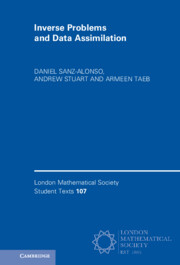Book contents
- Frontmatter
- Dedication
- Contents
- Preface
- Introduction
- Part I Inverse Problems
- 1 Bayesian Inverse Problems andWell-Posedness
- 2 The Linear-Gaussian Setting
- 3 Optimization Perspective
- 4 Gaussian Approximation
- 5 Monte Carlo Sampling and Importance Sampling
- 6 Markov Chain Monte Carlo
- Exercises for Part I
- Part II Data Assimilation
- 7 Filtering and Smoothing Problems and Well-Posedness
- 8 The Kalman Filter and Smoother
- 9 Optimization for Filtering and Smoothing: 3DVAR and 4DVAR
- 10 The Extended and Ensemble Kalman Filters
- 11 Particle Filter
- 12 Optimal Particle Filter
- Exercises for Part II
- Part III Kalman Inversion
- 13 Blending Inverse Problems and Data Assimilation
- References
- Index
11 - Particle Filter
Published online by Cambridge University Press: 27 July 2023
- Frontmatter
- Dedication
- Contents
- Preface
- Introduction
- Part I Inverse Problems
- 1 Bayesian Inverse Problems andWell-Posedness
- 2 The Linear-Gaussian Setting
- 3 Optimization Perspective
- 4 Gaussian Approximation
- 5 Monte Carlo Sampling and Importance Sampling
- 6 Markov Chain Monte Carlo
- Exercises for Part I
- Part II Data Assimilation
- 7 Filtering and Smoothing Problems and Well-Posedness
- 8 The Kalman Filter and Smoother
- 9 Optimization for Filtering and Smoothing: 3DVAR and 4DVAR
- 10 The Extended and Ensemble Kalman Filters
- 11 Particle Filter
- 12 Optimal Particle Filter
- Exercises for Part II
- Part III Kalman Inversion
- 13 Blending Inverse Problems and Data Assimilation
- References
- Index
Summary
This chapter is devoted to the particle filter, a method that approximates the filtering distribution by a sum of Dirac masses. Particle filters provably converge to the filtering distribution as the number of particles, and hence the number of Dirac masses, approaches infinity. We focus on the bootstrap particle filter (BPF), also known as sequential importance resampling; it is linked to the material on Monte Carlo and importance sampling described in Chapter 5.
- Type
- Chapter
- Information
- Inverse Problems and Data Assimilation , pp. 144 - 152Publisher: Cambridge University PressPrint publication year: 2023

